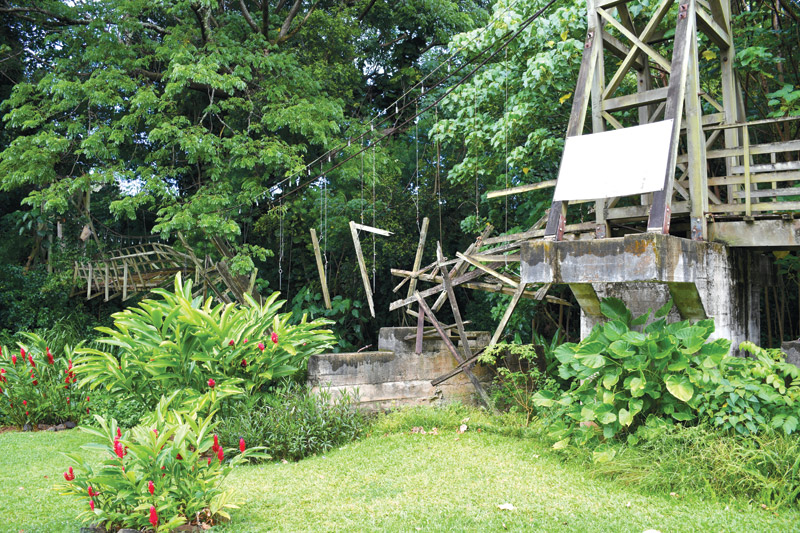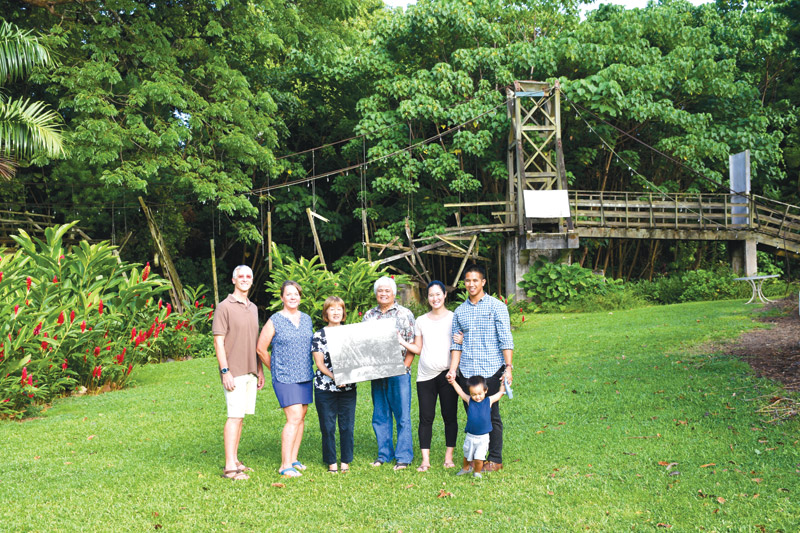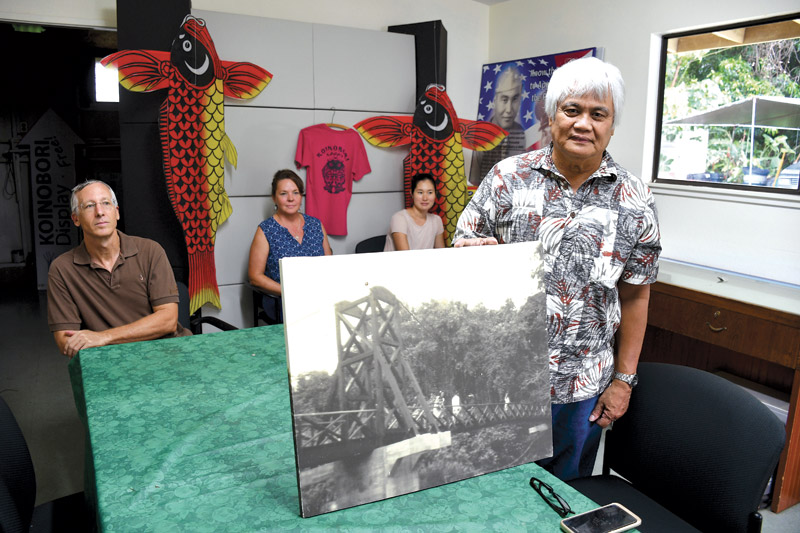Bridging Past + Present

After more than a decade of stagnation and neglect, Kapaia Swinging Bridge is finally on the road to restoration, thanks to county funding and a faction of good Samaritans.
Kapaia Swinging Bridge is in a sad state of disrepair — pieces of rotten wood dangle by their cable threads. But not for long.
Kapaia Foundation, which formed in 2006 following the bridge’s closure and subsequent neglect, was recently awarded a $231,000 grant from the county to bring the relic, which was constructed in 1948, back to life.
After facing 11 years of setbacks, Laraine Moriguchi, director of the group, is excited to finally be moving forward.
“We had ups and downs,” she says. “We’d have hope and then great disappointment, and then hope again, and then we were all disappointed.”
But that roller coaster has reached its pinnacle at long last, and is now cruising downhill. In March, Kaua‘i County transfered appropriated funds and ownership of Kapaia Swinging Bridge to Kapaia Foundation. The grant will cover supplies and equipment, but the rest is up to the community, which is why good Samaritans like architect Ron Agor are offering their services pro bono.

Kapaia Foundation members (from left) David and Nina Monasevitch, Laraine Moriguchi, Ron Agor, and Mia, Roy and Titus Goo have been working to restore Kapaia Swinging Bridge since its closure in 2006.
Agor jumped on board late last year after Jerome “The Shadow” Freitas approached him during breakfast at Tip Top Café. Agor, who is the foundation’s project manager, was inspired to join the team after Freitas told him about Moriguchi’s passion for the bridge. Since Agor has volunteered his architectural and engineering services for several community projects throughout the years, he was persuaded to assist with this one, as well.
“When a community group is so passionate about doing something and I can help, then I will,” he says.
The community’s passion for this particular project stems from a desire to preserve an important slice of Kaua‘i’s history. Kapaia Swinging Bridge served as a critical pedestrian pathway between Hanamā‘ulu, Kapaia and Līhu‘e. Hundreds of Līhu‘e Plantation Co. employees used the bridge to cross the Hanamā‘ulu waterway.
The bridge provided access to what Moriguchi calls the “bustling” town of Kapaia — complete with residences, Līhu‘e Hongwanji Mission, and businesses like Naganuma Store that sold candy and crack seed.

Ron Agor, Kapaia Foundation project manager, poses with a picture of Kapaia Swinging Bridge. He plans to reconstruct the bridge with the same design.
“It was packed,” recalls Moriguchi, who not only grew up next door to the bridge, but also owns part of the land it sits on.
People also used the bridge to get to work in the Hanamā‘ulu sugar cane fields, as well as to reach Immaculate Conception Catholic Church. And it was a safe way for people to gain access to Līhu‘e, right up until the moment it closed.
Ultimately, however, the bridge symbolizes the former plantation camp’s melting pot of cultures, including Filipino, Japanese, Chinese and Hawaiian workers , as well as the blending of each ethnicity’s unique way of life.
“It’s a big part of our history, even down to our diet and lifestyle,” says Roy Goo, president of Kapaia Foundation. “That plantation culture has played a bigger role in my upbringing than even my ethnic background, so I think it’s important to honor and preserve that.”
Goo’s efforts are also personal — he is married to Mia, whose mother is Moriguchi. His wife used to play on the bridge as a child while her grandfather, Harumi “David” Inagaki (Moriguchi’s father), would fish.
“I kind of feel responsible for it,” says Moriguchi about the bridge. “This is the most important project in my life. We love this area so much.”
While Moriguchi’s parents didn’t work for a plantation, she still feels a connection to the lifestyle and has a deep respect for the immigrants who traveled great distances to live on the island.
“And I want everybody to remember how they contributed to Hawai‘i,” she says.
Tree trimming and demolition are expected to commence mid-September. After that, assessments will be made to determine the extent of water damage within the structure, which will be followed by any necessary replacements, as well as the installation of metal brackets for stabilization. The final touches of the 80-foot bridge, which will replicate its original design, will include cables and a walkway. Agor is optimistic that the bridge will be serviceable again by the end of next year’s first quarter.
“It will give people a reason to walk again,” says Agor, who adds that the project must be completed by September 2018, at which point the grant expires.
The historic swinging bridge is one of four on the island — others are located in Waimea, Hanapēpē and Keapana – and was further battered in 2012 when a storm caused debris to pummel the structure. Despite its continued degradation, Kapaia Foundation members, including Nina Monasevitch, are relieved that the bridge will return to its former state of glory.
“To me, it’s one of the most special places on the island. It still has a feel of old Hawai‘i,” says Monasevitch, who moved to the island in 1978 and lives next door to the structure.
Her husband, David, is also a member of the group, and says the project couldn’t have happened without the continued perseverance of people like Moriguchi. If they hadn’t persisted and had waited for the county to reconstruct the bridge, it might not have happened. Moreover, it was estimated that it would have cost some $1 million.
“I hope it’s an inspiration for everybody, or any small group of people, who want to accomplish something,” he says.
Kapaia Foundation is still seeking volunteers to help with the construction. Visit savekapaiaswingingbridge.com for more information.
cocomidweek@gmail.com




